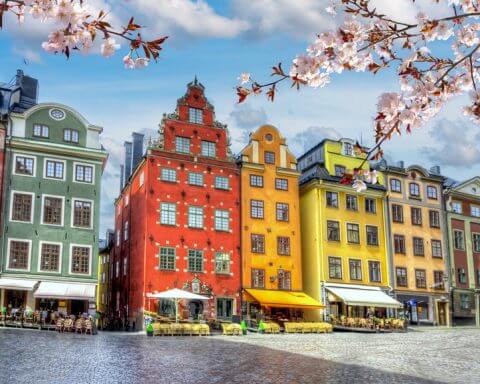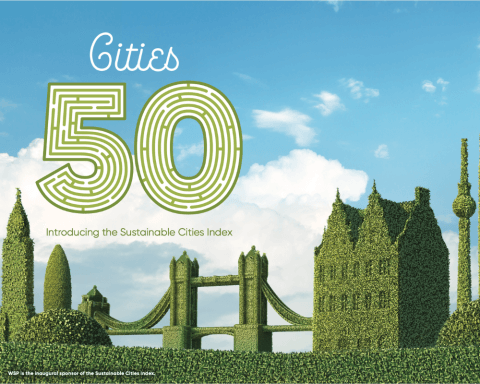In the fight against climate change, cities are proving to be much better combatants than the snoozing generals that are, all too often, national governments. Smaller and nimbler, cities are becoming showpieces of successful climate action, and the protagonists of this spectacle of municipal leadership are increasingly women.
The mayors of the top three cities in this year’s Sustainable Cities Index – Stockholm, Oslo and Copenhagen – are all women, but the trend is not unique to famously progressive Scandinavia; from Bogotá to Mexico City to Accra to Tokyo, female mayors around the world are distinguishing themselves as climate leaders. Indeed, 50% of the top 10 cities in the index are led by women. C40, the network of cities founded in 2005 by then London mayor Ken Livingstone to collectively promote climate action, has spawned a subgroup of female mayors. In 2014, they numbered four; three years later, they were 15, and their number continues to grow.
There’s no single explanation for this swell in female municipal leadership, and it’s risky to attribute certain qualities or strengths to women as a whole. Calgary Mayor Jyoti Gondek points out that while men are typically judged on their ability to deliver business results, women are expected to be caring and nurturing advocates for the weak and vulnerable, and for Mother Earth. To rise through the ranks in municipal politics, women have to prove their mettle in all areas, or, as Paris Mayor Anne Hidalgo has put it, “work 10 times harder than men.”
If any generalization can be made, then, it would be that by the time women land in the mayoral seat, they’ve learned how to fight. “You have to be unafraid,” says Gondek, whose first act upon being elected mayor of Canada’s oil and gas capital last November was to declare a climate emergency. Gondek felt the public statement was vital to Calgary’s future prosperity, framing it not in opposition to the oil and gas industry, but in keeping with a “transition and transformation” that has long since been underway but not yet become part of her city’s narrative.
It was a bold move for Calgary’s first female mayor, but this is something “first female mayors” are known for. When she was first elected in 2014, Hidalgo immediately and unabashedly tried to rid Paris’s centre of most cars, which she blamed for many of the city’s ills: air pollution, loud traffic and greenhouse gas emissions. In a highly symbolic move, she had the highway that ran along the left bank of the Seine converted into 4.5 hectares of pedestrian-only greenspace. She also announced a ban on all diesel cars by 2024 and petrol cars by 2030, while vowing to make Paris a cyclist’s dream by creating an additional 1,000 kilometres of permanent bike lanes and removing 72% of existing parking spots.
The moves provoked fierce opposition – and an unsuccessful legal challenge – from conservative and motorist groups. In a 2019 interview, Hidalgo attributed the “violence” of the reaction in part to her gender. “Being a woman that wants to reduce the number of cars meant that I upset lots of men,” she said, adding that two-thirds of public transport users are women.
To rise through the ranks in municipal politics, women have to prove their mettle in all areas, or, as Paris Mayor Anne Hidalgo has put it, “work 10 times harder than men.”
But the benefits of Hidalgo’s vision quickly became clear. Re-elected in 2020 for a second term, Hidalgo expanded the scope of her plans, packaging the ideas of Franco-Colombian systems theorist Carlos Moreno into the proposition of the “ville du quart d’heure,” or 15-minute city. Very much in the tradition of famed urbanist Jane Jacobs, the objective of this hyper-localism is to make it possible for city dwellers, wherever they live, to access the essentials of life – work, school, recreation, food, medical services – within a 15-minute walk or bike ride of their homes. The concept has quickly gained currency in cities around the world.
Following Hidalgo’s lead, Montreal Mayor Valérie Plante made the 15-minute city a central plank of her campaign for re-election last November, presenting the proximity to libraries and recreational and cultural facilities as an antidote to youth disengagement and rising gun violence. C40 has built its blueprint for post-pandemic urban recovery around the 15-minute city.
It’s a recurring theme with bold ideas; once implemented and experienced, they don’t seem so bold after all. Women mayors seem to understand this. In 2002, Annika Billström, the first female mayor of Stockholm, committed what was expected to be political suicide by proposing a congestion charge on all vehicles entering the inner city. Built on an archipelago and accessed largely by bridges, Stockholm was facing serious traffic problems, with two-thirds of workers in the downtown core commuting from the suburbs. Billström’s congestion-charge proposal was met with outrage, so she suggested that it be put to a referendum, but not before the city had tried it out. Over the course of a seven-month trial in which cars were charged roughly US$3 every time they crossed an electronic cordon into the downtown core, traffic volumes dropped by a fifth, travel times were significantly reduced, and a quarter of work commuters switched to public transit.
When the trial period ended, Stockholm reverted to its old ways, but Stockholmers viewed them differently. They realized the merits of fast roads over free roads. In the 2006 referendum, a majority voted in favour of the charge, and public support for it has only grown since then.
Three of the four mayors to succeed Billström in Stockholm have been women, and the city, which was named the European Commission’s first European Green Capital in 2010, continues to excel in its environmental and climate performance. Under Karin Wanngård, who served as mayor from 2014 to 2018, the city set itself a target of being not only carbon neutral but fossil-fuel free by 2040, five years earlier than the Swedish national goal. It also established higher standards for energy-efficient buildings than in the rest of the country.
Like many mayors, Wanngård understood the importance of the role model. Using her bike to get around in all seasons and proudly displaying her preference for second-hand clothes, she presented sustainability as an opportunity rather than an exercise in enforced belt-cinching. This can-do attitude is critical, as is the determination to use cities to demonstrate to other levels of government what is possible.
The Swedish capital has a tradition of collaborating formally with the private sector to achieve its goals. Established in 2007, the Stockholm Climate Pact is a network of businesses and organizations that work with the city’s leadership to develop and implement climate strategies. Anna König Jerlmyr, Stockholm’s mayor since 2018, is harnessing this cooperation in the “electrification pact” – an all-out effort to boost electric vehicle infrastructure and electrical capacity. By 2030, Stockholm aims for all parking spots in the inner city to be equipped with chargers and for all traffic there to be emission-free.
König Jerlmyr believes the city’s 2040 goal is well within reach.
Women mayors find inspiration in each other. Asked about exciting ongoing urban initiatives, König Jerlmyr points across the globe to Freetown, in Sierra Leone, where Mayor Yvonne Aki-Sawyerr has launched a project to plant one million trees on the denuded hills surrounding the capital city to mitigate flooding and landslides , while creating rural jobs to stem urban migration.
The project reflects the kind of lateral thinking that is required to address climate change, in both the Global South, where women mayors in Accra (Mayor Elizabeth K. T. Sackey), Mexico City (Mayor Claudia Sheinbaum Pardo) and Bogotá (Mayor Claudia López Hernández) are leading bold sustainability initiatives, and cities in the north. “I’ve always been after the triple bottom line,” says Calgary’s Gondek, referring to the triad of social, economic and environmental factors that inform good policy. “You have to blend priorities.”
Beate Weber-Schuerholz, the first female mayor of the southern German city of Heidelberg, who served in the position for 16 years beginning in 1990, believes this is something women do particularly well. “Women rarely have the chance to ascend the ladder directly,” she says, referring to the balancing act of family and career. “The steps they go up are very broad.”
She believes this shared experience makes women more inclined to compare notes – to learn from, rather than compete with, each other – and equips them well to confront the cross-cutting challenge of climate change, at once highly technical and deeply human.
Meet five women mayors blazing a greener trail
Anna König Jerlmyr
Stockholm, Sweden
Anna König Jerlmyr wants Stockholm to become the world’s first climate-positive city by 2040 and fossil-fuel free by 2030. To do so, she is looking to completely electrify the city’s transit system and take advantage of emerging carbon capture and storage technology.
Jyoti Gondek
Calgary, Alberta
One of Jyoti Gondek’s first orders of business after she was elected in 2021 was to pass a motion in city council declaring a climate emergency. In her campaign to become Calgary’s first female mayor, Gondek made climate change and resilience a key priority for the oil and gas capital of Canada.
Claudia Sheinbaum Pardo
Mexico City, Mexico
As a former environmental engineer, Claudia Sheinbaum Pardo (Mexico City’s first female mayor, elected in 2018) focuses her efforts on reducing vehicle emissions and expanding the city’s public transit. Her ambitious plans also include tackling the water crisis.
Valérie Plante
Montreal, Quebec
First elected in 2017 (and re-elected in 2021), Valérie Plante has led Montreal’s campaign to slash emissions by 55% below 1990 levels by 2030. She also plans to implement a zero-emission zone in downtown Montreal by 2030, plant 500,000 trees and electrify public transport.
Anne Hidalgo
Paris, France
Anne Hidalgo has led a transformation of the streets and public squares of Paris to make them more friendly to walking and cycling since she was elected in 2014. Her administration has shut off car access on one side of the river Seine and spent €150 million building 300 kilometres of bike lanes.






